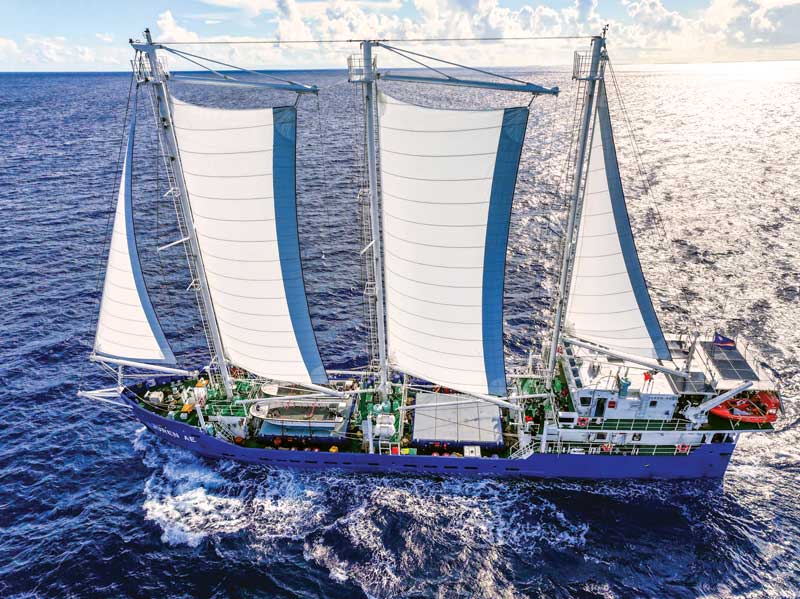
Just as ship owners during the great age of sail sought out Maine sea captains to safely carry passengers and cargo to the far corners of the globe, a German company called upon a Rockport skipper to help rig and command a revolutionary solar- and sail-powered ship designed to ply the Pacific Ocean’s far-flung Marshall Islands.
In launching its new vessel, the company, Deutsche Gesellschaft fur Internationale Zusammenarbei, known in English as the German Society for International Cooperation, or GIZ, approached Christina “Chrissy” Shyne. They asked her to help integrate ancient “schooner technology” from centuries ago into a 21st-century sailing cargo ship that will eschew fossil fuel, and instead be propelled by the wind and function on solar-powered electricity.
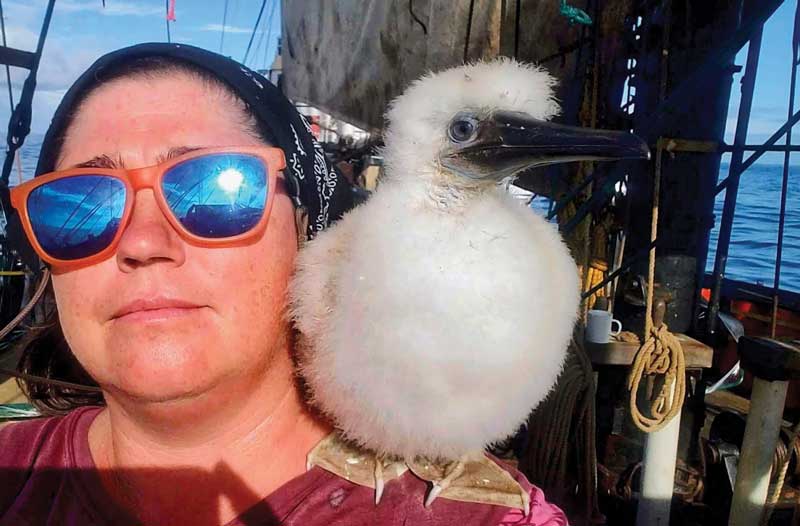
The Juren Ae was designed specifically to supply the thousands of tiny islands that make up the Marshalls and help address problems such as the scarcity of water and food in the remote archipelago.
“There are very few other modern sailing cargo vessels,” Shyne said of the Juren Ae. “It employs an Indo-Sail rig and is only the fourth to be constructed so far.”
Shyne said the company is exploring a proof-of-concept to see if such a vessel will work on this scale so that it can be expanded. The International Marine Organization has a goal to reduce carbon emissions by at least 40 percent by 2030 and to reach net-zero green-house gas emissions by or around 2050. Internationally there is a huge push to find alternative options to current shipping methods that rely on fossil fuels.
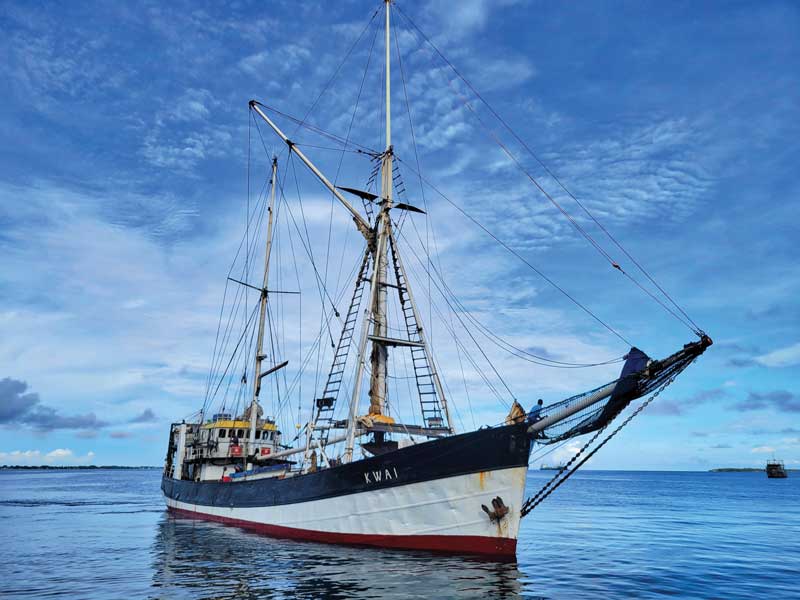
“They reached out to me to see if I wanted to join the team building the boat in South Korea, beginning in March 2024,” Shyne said.
So just how did a sea captain from Rockport end up in South Korea rigging a futuristic cargo and passenger vessel? In Shyne’s case, a formal education was not in the cards. Rather she got to where she is thanks to hard work and a generous dose of tenacity.
In 2001 Shyne moved from Seattle, Washington, to Key West, Florida, to start working on boats. “I went to Key West on vacation, went sailing, and fell in love with it,” she said. “I sold everything from my apartment in Seattle, and drove to Key West by myself to learn to sail.”
In Florida, she bought a small liveaboard sailboat and started working on a day-charter boat called Wolf. Two years later, she moved to New Orleans, which she called home until hurricane Katrina struck. Though she was out of town, working in Seward, Alaska, to beat the summer heat when the monster storm “destroyed everything,” the hurricane shook her up. In its aftermath, she returned to Key West, where she took a job aboard the schooner Liberty Clipper. It was there that she began making Maine connections while working with Camden schooner Capt. Aaron Lincoln, Liberty’s skipper.
“I returned to New Orleans, put the remains of my possessions on the sidewalk, gave the keys of my flooded vehicle to a friend, and returned to Key West to finish out the season with the Liberty fleet,” she recalled. Then come spring, she sailed with the ship to Maine.

About 15 years ago, Shayne earned a 100-ton, near coastal captain’s ticket, which led to a 200-ton near coastal license. And along the way, she bought property in Rockport. For a dozen years, she spent her summer months there, first as head instructor and later program director of the Rockport Boat Club’s summer youth sailing program. And during that time, it was the close-knit group of Maine sea captains that she met that broadened her horizons even farther afield.
“My friend Cully Dorer got a job on a sailing cargo ship in the Pacific, and I looked them up and I applied for a job. That was 2013,” she said, recalling how she began working aboard the Kwai, a 135-foot sailing cargo vessel that carried all manner of goods, sailing from Honolulu, Hawaii, to Kiribati (formerly known as the Gilbert Islands) and the Northern Cook Islands. She didn’t get called back for a second season the next year, she said, “but then in 2015 I got a call and they said ‘Can you come?’ and they gave me, like two weeks to get there!”
Her job? “I was hired as a ‘super cargo,’ which is sort of like an onboard manager. Basically, that means I was responsible for everything related to cargo.”
“People on these isolated islands could call or email the Kwai’s office and place orders for absolutely anything,” she said. The office staff would source and order the products or create lists for the Kwai’s shopper to buy in Hawaii. A lot of products arrived from Amazon, but huge amounts were also purchased from Walmart (bicycles, housewares, etc.), Costco (food items of all types), and close to a hundred small businesses. The filled orders would arrive at the Kwai warehouse where the packages were opened, inventoried, labeled, and resorted into totes by customer name and island location. Then the items were palletized and labeled for destination and staged for loading, Shyne said.
In the islands, she said, “Nearly everyone has an iPad or tablet and that’s what they use. Island residents mostly live in ‘kia kias,’ which are one-room raised huts, built of wood, with thatched roofs made of woven pandamas leaves. Many of these kia kias have solar panels and battery banks. “The amount of electronic equipment there is surprising,” she noted. “I went by a crew mate’s kia kia one day to find him playing FIFA World Cup soccer on a very large TV.”
Aboard the Kwai, cargo was loaded below and on deck under a tent that could be tied down. The tent might also house up to 70 passengers who were en route to various islands.
“Usually the passengers were on board for less than 48 hours, traveling inter-island, but one group of passengers in the Marshall Islands were on board for almost two weeks while the Kwai did a pre-Christmas run from island to island. It was a family—husband, wife, two young girls, and their two pigs. We all had a very nice Christmas together onboard Kwai.”
In addition to being super cargo and purser, she was a watch officer at sea. On trips she worked as second mate and ship’s rigger. But she said she still did the cargo organization work as well. Her sea time allowed her to qualify for her 200-ton license in 2019.
The Kwai was owned by Brad Ives, a name that may sound familiar because his previous business involved a sailing cargo ship that sailed from Suriname to the northeastern U.S., delivering tropical hardwoods harvested for shipbuilding. He occasionally did deliveries to Rockport.
In 2020, during the height of the COVID pandemic, The Marshall Island Shipping Corp., a government-run shipping operation that provides food, building materials, and transportation from the capital to out islands, purchased the Kwai. At the time, Shayne was serving as mate.
Under the new owner, Shyne was contracted by GIZ, one of its partners, to support the incorporation of the Kwai into MISC’s existing fleet by developing a sail-training curriculum and to lead sail training events. “I ended up working in the Marshall Islands for seven months during that transition period,” Shyne said.
“The Kwai was GIZ’s first attempt at incorporating a large sailing ship into a modern sailing company,” she said.
Then last year Shyne heard from the GIZ group that it was working on a new modern sailing ship for the Marshall Islands, the innovative Juren Ae. The boat was being built at a South Korean yard on Geoje Island. The yard needed help in outfitting the ship, particularly its standing and running rigging. The ship builders constructed the masts, spars, furling pipes, and all the mechanical parts, Shyne said, but the actual rigging work was more akin to yachting than to tall ships. Help was needed to fill this gap and Shyne was there to assist.
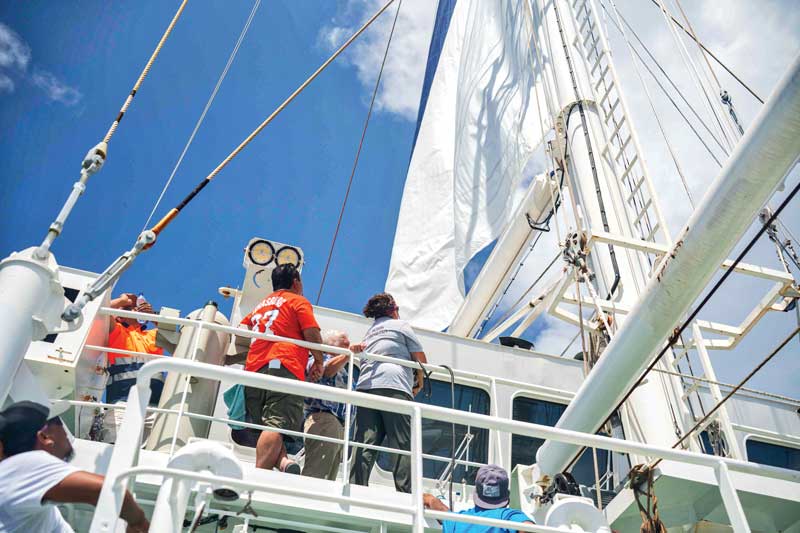
So too was former Kwai crew member Evyathar Ben-Reseph. He was on site as the representative for MISC.
“An amazing engineer, he took the lead assembling and working with the workers at Asia Shipbuilding and the sailmaker to provide technical support to the project” Shyne said, adding that she was called upon to translate her knowledge of age-old schooner technology into a 21st-century sail plan.
The Juren Ae’s rigging system is controlled and operated by electronic systems powered by the sun. But in the end, it will rely on centuries’ old technology: blocks and rigging. That’s why Shyne got the call to assist Ben-Reseph with the completion of the rig.
“I joined the project the first of March [2024]. After a few weeks of working with Evy it became apparent that additional help would be needed to complete the rig by the rapidly approaching deadline,” she said. “Two former Kwai crew members, Carson Tak and Ben Kukolj, both flew out from Canada to join the project, and the MISC sent Kwai first mate Teitera Turei out to join our rig team.
“Over the next two months we built the sailing rig. We spliced lines, ran up and tuned stays and shrouds. We worked with welders and fabricators for placement of cleats and block placement. Many rig parts and rigging tools are just not available in South Korea, so many items had to be fabricated by the shipyard or improvised by the rig team.”
Shyne recalled, “On Fridays, Evy and I would occasionally take the bus up to Busan to consult with Mr. Park, the sailmaker, who had his own set of challenges making these huge sails out of very thick canvas.”
The Juren Ae departed South Korea June 1, 2024, on its maiden voyage. It was not without a few glitches and issues that had to be dealt with and worked out over the course of the 3,500-nautical-mile, 23-day journey. But after years of design and construction the nine-member crew, including Shyne as chief mate, sailed the Juren Ae to the Marshall Islands and into the future.
✮
Lynette Walther is a MBH&H contributing editor who writes frequently about gardening and other topics. She lives in Camden.
A postscript from Christina Shyne
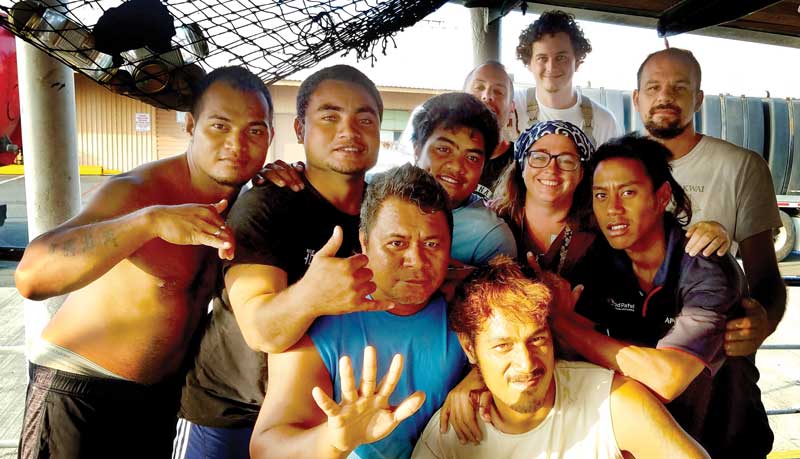
My first season aboard the Juren Ae has ended. TheJuren Ae is now being run by former Kiribati co-workers from the cargo sailing ship Kwai, Capt. Teitera Turei and chief mate Frank Tabuaka. After completion of two cargo deliveries from Majuro to the outer islands the Juren Ae is currently sailing in the Majuro lagoon, hosting sails for foreign dignitaries interested in this prototype ship for their own island nations.
The Juren Ae and crew are also working with the College of the Marshall Islands, Maritime Training Center Jela Meto. Students, led by their professors, are using the Juren Ae as a floating classroom to learn about ship systems, emergency protocols, and much more. Interns from the Jela Meto work alongside the ship’s crew to earn sea time for their future maritime careers. —Christina Shyne
About the ship
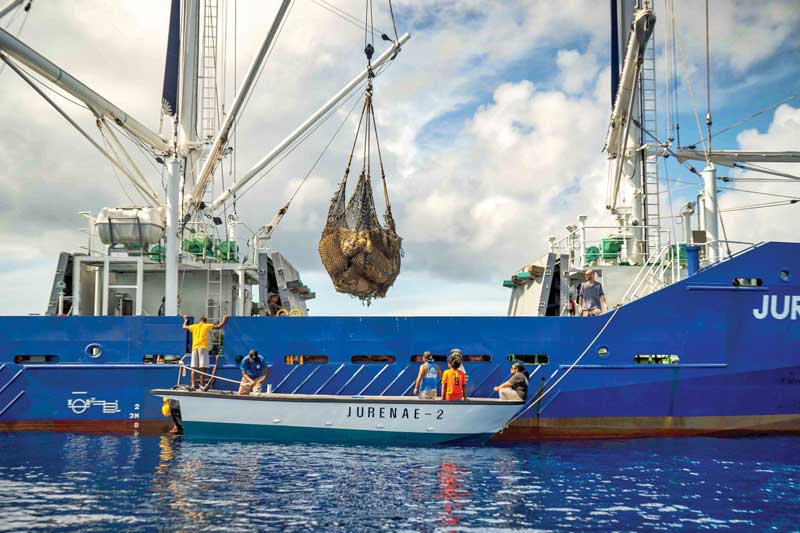
The future of the Juren Ae is mapped out, according to crew member Christina “Chrissy” Shyne of Rockport. It will commute throughout the Marshall Islands, from the capital, Majuro, to the atolls that number more than 1,000 islands. It will deliver everyday goods as well as transport copra, which is dried coconut, from the islands to Majuro for further processing to become an oil used in a variety of products.
A captain’s log entry describing the maiden voyage of the Juren Ae reports, “The first days on the high seas passed quickly—literally: The Kuroshio Current drove us in the desired direction with an additional boost of up to 3 knots. With an average speed of 10 knots we covered a lot of distance. For the next 1,200 nautical miles, we will keep a more southerly course. The sun is shining, it is gradually getting warmer in the ship, and our solar panels are soaking up a lot of energy.”
According to the website The Maritime Executive, the Juren Ae is a collaborative effort, a “Transition to low-carbon sea transport in the Republic of the Marshall Islands;” it is a project of the German Society for International Cooperation (GIZ). Other partners include KR Korean Registry (international ship registry); the University of Applied Sciences Emden-Leer in Germany; Marshall Islands Sea Corp.; Asia Shipbuilding Co.; and naval design company Kostec Co. Ltd. in Busan, among others. The ship was designed at the campus of Emden/Leer University of Applied Sciences and constructed at Asia Shipbuilding in Geoje City, South Korea.
Juren Ae is 157 feet long. It employs a partially automated sail system designed by German naval designer HSVA, adapted from a traditional Indonesian sail design. It also has a hybrid drive system and is projected to reduce CO2 emissions by approximately 80 percent compared to similar-sized ships, according to the report. —Lynette Walther
A mariner’s account of the Marshall Islands
The Marshall Islands are on the opposite side of the world from Maine, but there is so much more than distance that separates the two.
In the winter months when Maine is in deep-freeze mode, Maine sea captain Christina Shyne becomes a vital part of that other world, working to deliver some of the necessities of life there.
The Marshall Islands are a sprawling chain of volcanic islands and coral atolls in the central Pacific Ocean. During World War II, the islands were a part of the fierce battle for control of the Pacific, with many Japanese installations located there, and which are still there to this day. Even now, on some islands residents occupy those long-abandoned structures.
“I think most tourists wouldn’t be interested in them (the islands), they are isolated atolls in the middle of the ocean, and most are not developed at all,” Shyne said. “They do have beautiful white sands, clear waters and interesting snorkeling, but they are so far to get to.”
That distance of miles and space is just one of the reasons life on the islands is so different from the life we know in Maine, she said.
“The people there are very different from Americans, and it is always a culture shock when I come back,” Shyne said. “The Marshall islanders are very open, caring people, and conflict and arguments are taboo. Honesty is very important to them, because they need harmony to co-exist on those islands.
“That means they never use the word ‘no’ to a question,” she said, adding that she has learned to be patient and “look for other signs” to understand their intent when “no” is exactly what is on their mind, though never on their lips. On some of the larger islands, the residents speak English, but most all speak Marshallese, and different dialects of that language.
The islands in the 800-nautical mile chain are more accurately atolls. Each is surrounded by a lagoon, which provides a safe location for residents to fish, with their catch being one of the main staples of their diets. Most of the lagoons are miles wide—so wide it is impossible to see the far shore.
“Most of the time we are delivering cargo from inside the lagoon, where it is protected and calm,” Shyne explained. She noted that 99 percent of the islands don’t have docks where the cargo vessel can tie up to off-load or take on cargo, so small boats are dispatched to ferry goods to and from shore. Shyne said the only “dock” they can access is a remnant of a long-ago bombed-out Japanese landing area on one island. She said enough of the structure remains where they can tie up.
Strolling the beaches throughout the Marshalls, one often finds old bullet and shell casings. And today, island children play and ride their bicycles on abandoned Japanese air strips.
Travel between the many islands is common, and because populations on most of the islands are often small—a hundred or more residents—the schools are on certain islands, and students go to them to live for the school season. Having islanders onboard during their passages is common, and Shyne has absorbed the culture and become acquainted with the people during those voyages. Passing time between islands, the Kiribati natives sing, and their songs and vocalizing are other-worldly, like nothing she had ever heard. —Lynette Walther






